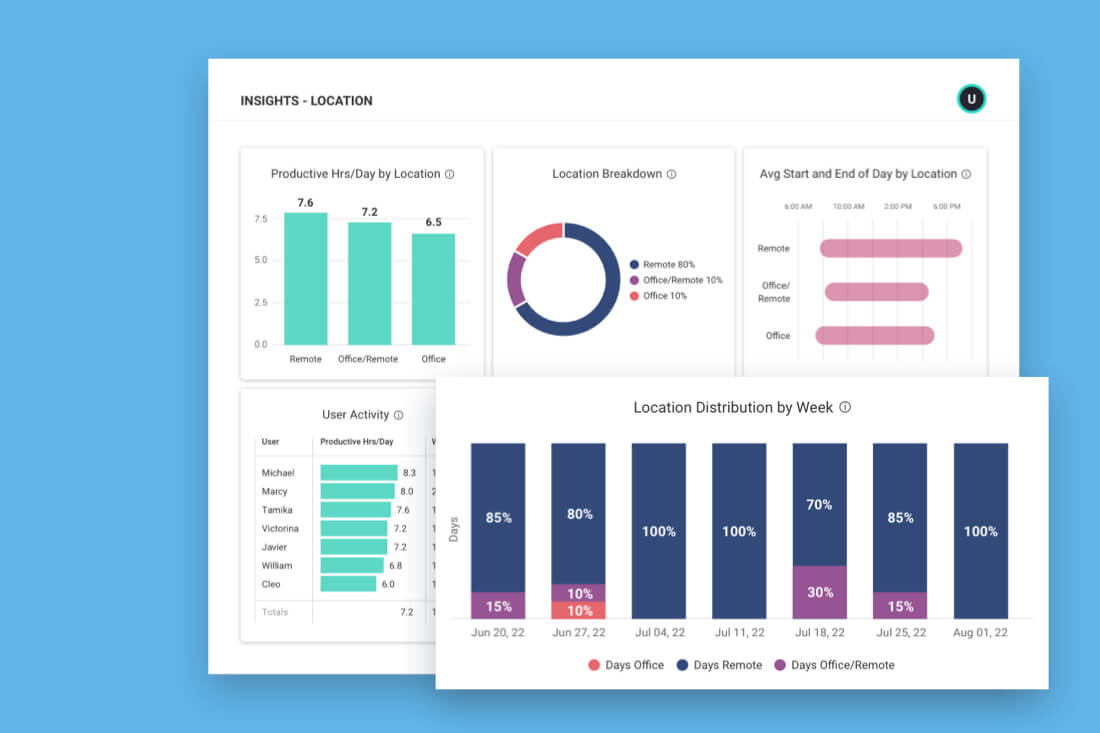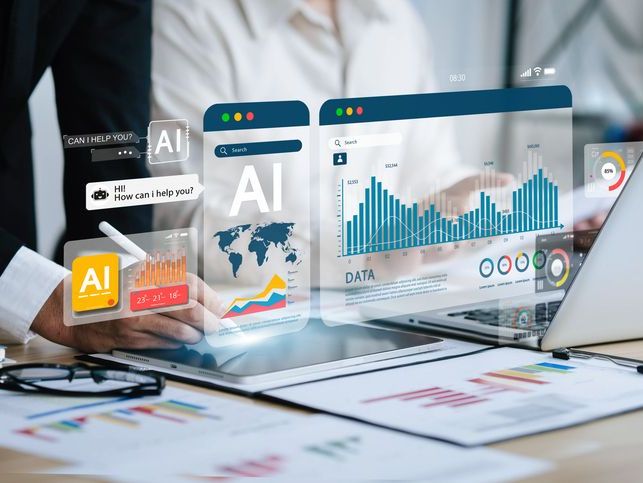Remote work took center stage during the COVID-19 pandemic, and many businesses still find it the best way to operate now as some workers return to offices. Hybrid workforces (those using both on-site and remote work options) are becoming the new norm. While a hybrid workplace model can offer a number of benefits, like better collaboration opportunities tied to better work-life balance, some managers find it challenging to get a handle on employee performance and productivity. One way to do so is to use a hybrid workforce monitoring solution, which allows managers to track the productivity of hybrid employees.
In this blog, we’ll discuss hybrid workforce monitoring including an overview, benefits and how to start using this software.
What is a hybrid workforce?
A hybrid workforce is any team that spends time working on-site at an office and remotely. Hybrid teams can include groups of people who work remotely full-time alongside employees who come into an office, employees who all have the same set days working remotely and together in the office, or teams whose employees work remotely or in the office on different days.
The role of monitoring in hybrid work environments
Employee monitoring is an important aspect of hybrid workforce management. It allows managers to track productivity and engagement across the team, regardless of whether they’re on-site or remote. It also allows managers and team members to identify both successes and opportunities for improvement, and to find and address performance issues before they become a problem.
Key components of an effective hybrid workforce monitoring system
To create an effective hybrid employee monitoring system, you need a combination of technology tools and human oversight. Technology solutions like monitoring software and communication platforms provide data and automation opportunities. Human oversight can include managing communication, data analysis and performance evaluations. By combining these two elements, businesses can make sure they have a comprehensive overview of how workforce performance is going in a hybrid environment.
Benefits of hybrid workforce monitoring
By tracking employee productivity and engagement across work arrangements, hybrid workforce monitoring benefits businesses that implement it effectively. Key benefits include:
Increased productivity
The first benefit that hybrid workforce monitoring can provide is improved productivity. Managers can identify areas where employees are less efficient and take steps to improve those processes. Teams can find ways to implement new tools or processes to improve communication or identify workload imbalances to ensure all team members can do their work most efficiently. The software is particularly valuable for hybrid workforces, as it helps managers maintain visibility over remote employee workflows and ensure they work effectively outside of an office environment.
Enhanced employee engagement
Employee monitoring also helps with employee engagement by giving team members access to feedback and performance-related data. When they have a clear understanding of how their work contributes to overall company goals, employees are more likely to be engaged and motivated. This also has enhanced value for hybrid workforces, which otherwise may feel disconnected from their peers and the organization.
Improved work-life balance
One of the biggest perks that work-from-home employees report is improved work-life balance, and employee monitoring can help maintain this momentum for hybrid workers. By effectively using workforce monitoring systems, managers can identify spots where employees may be overworked and make adjustments to work hours to prevent burnout. Tying in the earlier point about improved productivity, employees may also find that improved workflows enable them to finish projects on time which reduces the need to work outside of standard office hours.
Better communication and collaboration
Remote workers often find barriers to communication and collaboration. These can be improved through employee monitoring by providing insight into communication patterns. Managers can take steps to ensure that all team members are engaged and connected by seeing where remote employees are missing communication capabilities.
Implementing hybrid workforce monitoring
While implementing a hybrid workforce monitoring solution can bring a lot of benefits to an organization, it’s important to implement it in an effective and ethical way. Below are some key considerations to keep in mind when implementing a new hybrid workforce monitoring solution.
Choose the right monitoring tools
When choosing which employee monitoring system to use, it’s important to consider compatibility with existing systems, ease of use and the ability to customize settings. You should also consider what you intend to monitor, such as working hours, communication, project management and technology usage. Spending time to carefully consider these factors will help ensure you have a smooth implementation process without issues.
Establish clear monitoring policies
You should always be transparent with employees about what data will be collected, how it will be used and who will have access to it. Establish clear policies that outline employee expectations, data security measures and any disciplinary procedures for violations.
Train employees and managers on monitoring practices
It’s not enough just to inform employees and managers of your intentions in workplace monitoring, or for them to sign a piece of paper saying they understand. Full adoption will require training to ensure that data is collected accurately and ethically. Managers need to be equipped with the skills and knowledge necessary to analyze and use the data effectively.
Balance privacy and accountability
Finally, it’s important to find a balance between employee privacy and accountability when implementing a new hybrid workforce monitoring solution. While monitoring can be a valuable tool when used properly, it’s essential to respect employees’ rights to privacy and ensure data is collected only for legitimate business purposes. This can be an issue both with building trust within your organization as well as having possible legal implications outside your organization.
Analyzing and using hybrid workforce monitoring data
While hybrid workforce monitoring systems can gather a lot of data, if you don’t have a plan to analyze and use it, it’s pointless. Use these guidelines to put your employee monitoring data to work:
Identify patterns and trends
Businesses need to analyze monitoring data regularly and intentionally to find patterns and trends in employee behavior and productivity. Use this data to find areas ready for improvement or where employees may need additional training or resources.
Address performance issues
With monitoring data arriving in almost real time, it can be easier to identify performance issues and take steps to address them before they become a problem. This may include offering struggling employees additional training or support or adjusting workloads to make sure everyone is able to work at their best.
Optimize workflows and processes
Analyzing monitoring data allows businesses to find opportunities to improve workflows and processes. This may include changing schedules, communication patterns or task assignments to help eliminate inefficiencies and streamline overall operations. You can also identify which types of technology are working best for your employees and find gaps where new technology or training may be needed.
Measure the impact of monitoring on efficiency
Monitoring data can also provide insight into how the monitoring process is affecting efficiency. By regularly reviewing performance data and comparing it to pre-monitoring levels, you can gain a clear understanding of the return on investment that hybrid workforce monitoring provides.
Get started with hybrid workforce monitoring with ActivTrak
If you have a hybrid workforce, monitoring software can help maximize productivity for all of your team members. ActivTrak offers employee monitoring solutions that provide the right technology and human oversight so you can use data effectively, gain insight into employee performance and take steps to improve productivity across the board. Get a free demo today.





